Assessing Models of Sea Level Rise and Mean Sea Surface with Sentinel-3B and Jason-3 Altimeter Data near Taiwan: Impacts of Data Quality and Length
Abstract
1. Introduction
2. The Study Area and Data
2.1. The Study Area and Altimeter Missions
2.2. Global Models of Sea Level Rise Rate around Taiwan
2.3. The Mean Sea Surface Models and Global Geoid Model
3. Method for Determining Along-Track Sea Surface Heights and Their Rates of Change
3.1. Determining Satellite Reference Ground Tracks
3.2. Reduction of Sea Surface Heights to the Reference Tracks
3.3. Outlier Detection
3.4. Removing Nearshore Altimeter Data and Sample Time Series
4. Results and Discussion
4.1. The Along-Track SLR Rates: Impact of Data Quality
4.2. The Short-Term SLR Rates and the Long-Term Rates: Differences and Cautions
4.3. Accuracies of the MSS Models: Update Frequency
5. Conclusions
Author Contributions
Funding
Data Availability Statement
Conflicts of Interest
References
- Nicholls, R.J.; Cazenave, A. Sea-level rise and its impact on coastal zones. Science 2010, 328, 1517–1520. [Google Scholar] [CrossRef] [PubMed]
- Nicholls, R.J.; Marinova, N.; Lowe, J.A.; Brown, S.; Vellinga, P.; de Gusmao, D.; Hinkel, J.; Tol, R.S.J. Sea-level rise and its possible impacts given a beyond 4 C world in the twenty-first century. Philos. Trans. R. Soc. A 2011, 369, 161–181. [Google Scholar] [CrossRef] [PubMed]
- Cazenave, A.; Dieng, H.B.; Meyssignac, B.; Schuckmann, K.V.; Decharme, B.; Berthier, E. The rate of sea-level rise. Nat. Clim. Chang. 2014, 4, 358–361. [Google Scholar] [CrossRef]
- Niu, Y.; Guo, J.; Yuan, J.; Zhu, C.; Zhou, M.; Liu, X.; Ji, B. Prediction of sea level change in Japanese coast using singular spectrum analysis and autoregression moving average. Chin. J. Geophys. 2020, 63, 3263–3274. [Google Scholar]
- Voosen, P. Seas are rising faster than ever. Science 2020, 370, 901. [Google Scholar] [CrossRef]
- Cazenave, A.; Llovel, W. Contemporary SLR. Annu. Rev. Mar. Sci. 2010, 2, 145–173. [Google Scholar] [CrossRef]
- Guo, J.; Wang, J.; Hu, Z.; Hwang, C.; Chen, C.; Gao, Y. Temporal-spatial variations of sea-level over China seas derived from altimeter data of TOPEX/Poseidon, Jason-1 and Jason-2 from 1993 to 2012. Chin. J. Geophys. 2015, 58, 3103–3120. [Google Scholar]
- Mu, D.; Yan, H. The instantaneous rate of global mean sea-level rise. Chin. J. Geophys. 2018, 61, 4758–4766. [Google Scholar]
- Tseng, Y.H.; Breaker, L.C.; Chang, E.T.Y. Sea level variations in the regional seas around Taiwan. J. Oceanogr. 2010, 66, 27–39. [Google Scholar] [CrossRef]
- Lan, W.H.; Kuo, C.Y.; Kao, H.C.; Lin, L.C.; Shum, C.K.; Tseng, K.H.; Chang, J.C. Impact of geophysical and datum corrections on absolute sea-level trends from tide gauges around Taiwan, 1993–2015. Water 2017, 9, 480. [Google Scholar] [CrossRef]
- Hung, W.C.; Hwang, C.; Chen, Y.A.; Zhang, L.; Chen, K.H.; Wei, S.H.; Lin, S.H. Land subsidence in Chiayi, Taiwan, from compaction well, leveling and alos/palsar: Aquaculture-induced relative SLR. Remote Sens. 2017, 10, 40. [Google Scholar] [CrossRef]
- Hwang, C. Depth modernization. Presented at the Taiwan Geosciences Assembly, Taipei, Taiwan, 7–10 June 2022. Available online: http://www.cgu.org.tw/index.php/2022-taiwan-geosciences-assembly-tga (accessed on 27 September 2021).
- Andersen, O.B.; Knudsen, P. DNSC08 mean sea surface and mean dynamic topography models. J. Geophys. Res. Ocean. 2009, 114, 327–432. [Google Scholar] [CrossRef]
- Marsh, J.G.; Koblinsky, C.J.; Zwally, H.J.; Brenner, A.C.; Beckley, B.D. A global mean sea surface based upon GEOS 3 and Seasat altimeter data. J. Geophys. Res. 1992, 97, 4915–4921. [Google Scholar] [CrossRef]
- Yuan, J.; Guo, J.; Niu, Y.; Zhu, C.; Li, Z. Mean Sea Surface Model over the Sea of Japan Determined from Multi-Satellite Altimeter Data and Tide Gauge Records. Remote Sens. 2020, 12, 4168. [Google Scholar] [CrossRef]
- Hernandez, F.; Schaeffer, P. The CLS01 Mean Sea Surface: A Validation with the GSFC00.1 Surface; CLS: Ramonville St Agne, France, 2001. [Google Scholar]
- Schaeffer, P.; Ollivier, A.; Faugere, Y.; Bronner, E.; Picot, N. The new CNES CLS 2010 mean sea surface. In Proceedings of the Oral Presentation at OSTST Meeting, Lisbon, Portugal, 18–22 October 2010; pp. 21–22. [Google Scholar]
- Schaeffer, P.; Faug’ere, Y.; Legeais, J.F.; Ollivier, A.; Guinle, T.; Picot, N. The CNES_CLS11 Global Mean Sea Surface Computed from 16 Years of Satellite Altimeter Data. Mar. Geod. 2012, 35 (Suppl. 1), 3–19. [Google Scholar] [CrossRef]
- Pujol, M.I.; Schaeffer, P.; Faugère, Y.; Raynal, M.; Dibarboure, G.; Picot, N. Gauging the improvement of recent mean sea surface models: A new approach for identifying and quantifying their errors. J. Geophys. Res. Ocean. 2018, 123, 5889–5911. [Google Scholar] [CrossRef]
- Andersen, O.B.; Knudsen, P.; Stenseng, L. The DTU13 MSS (mean sea surface) and MDT (mean dynamic topography) from 20 years of satellite altimetry. In Proceedings of the 3rd International Gravity Field Service (IGFS), Shanghai, China, 30 June–6 July 2014; Jin, S., Barzaghi, R., Eds.; Springer: Cham, Switzerland, 2015; Volume 144, pp. 111–121. [Google Scholar]
- Andersen, O.B.; Piccioni, G.; Stenseng, L.; Knudsen, P. The DTU15 MSS (mean sea surface) and DTU15LAT (lowest astronomical tide) reference surface. In Proceedings of the ESA Living Planet Symposium 2016, Prague, Czech Republic, 9–13 May 2016. [Google Scholar]
- Andersen, O.B.; Knudsen, P.; Stenseng, L. A new DTU18 MSS mean sea surface improvement from SAR altimetry. In Proceedings of the 25 Years of Progress in Radar Altimetry Symposium, Ponta Delgada, Portugal, 24–29 September 2018. [Google Scholar]
- Jiang, W.; Li, J.; Wang, Z. Determination of global mean sea surface WHU2000 using multi-satellite altimetric data. Chin. Sci. Bull. 2002, 47, 1664–1668. [Google Scholar] [CrossRef]
- Jin, T.Y.; Li, J.C.; Jiang, W.P.; Wang, Z.T. The new generation of global mean sea surface height model based on multi-altimetric data. Acta Geod. Cartogr. Sin. 2011, 40, 723–729. [Google Scholar]
- Jin, T.Y.; Li, J.C.; Jiang, W.P. The global mean sea surface model WHU2013. Geod. Geodynamics 2016, 7, 202–209. [Google Scholar] [CrossRef]
- Parisot, F.; Wilson, S. EUMETSAT and NOAA—The Jason-2 follow-on issue. In Proceedings of the 2008 OSTST (Ocean Surface Topography Science Team Meeting) Meeting, Nice, France, 10–15 November 2008. [Google Scholar]
- Parisot, F. EUMETSAT Altimetry programs. In Proceedings of the OSTST (Ocean Surface Topography Science Team) 2009 meeting, Seattle WA, USA, 22–24 June 2009. [Google Scholar]
- Bannoura, W.; Parisot, F.; Vaze, P.; Zaouche, G. J3 Project Status. In Proceedings of the OSTST (Ocean Surface Topography Science Team) 2012 Meeting Presentations, Venice, Italy, 27–29 September 2012. [Google Scholar]
- Barnoud, A.; Picard, B.; Meyssignac, B.; Marti, F.; Ablain, M.; Roca, R. Reducing the uncertainty in the satellite altimetry estimates of global mean sea level trends using highly stable water vapour climate data records. J. Geophys. Res. Ocean. 2023, 128, e2022JC019378. [Google Scholar] [CrossRef]
- Yuan, J.; Guo, J.; Zhu, C.; Hwang, C.; Yu, D.; Sun, M.; Mu, D. High-resolution sea level change around China seas revealed through multi-satellite altimeter data. Int. J. Appl. Earth Obs. Geoinf. 2021, 102, 102433. [Google Scholar] [CrossRef]
- Chen, T.W. Examining SLR and Mean Sea Surface Models around Taiwan Using Latest Satellite Altimetry Data from S3B and J3. Master’s Thesis, National Yang Ming Chiao Tung University, Hsinchu, Taiwan, 2022. [Google Scholar]
- Pavlis, N.K.; Holmes, S.A.; Kenyon, S.C.; Factor, J.K. The development and evaluation of the Earth Gravitational Model 2008 (EGM2008). J. Geophys. Res. Solid Earth 2012, 117, B04406. [Google Scholar] [CrossRef]
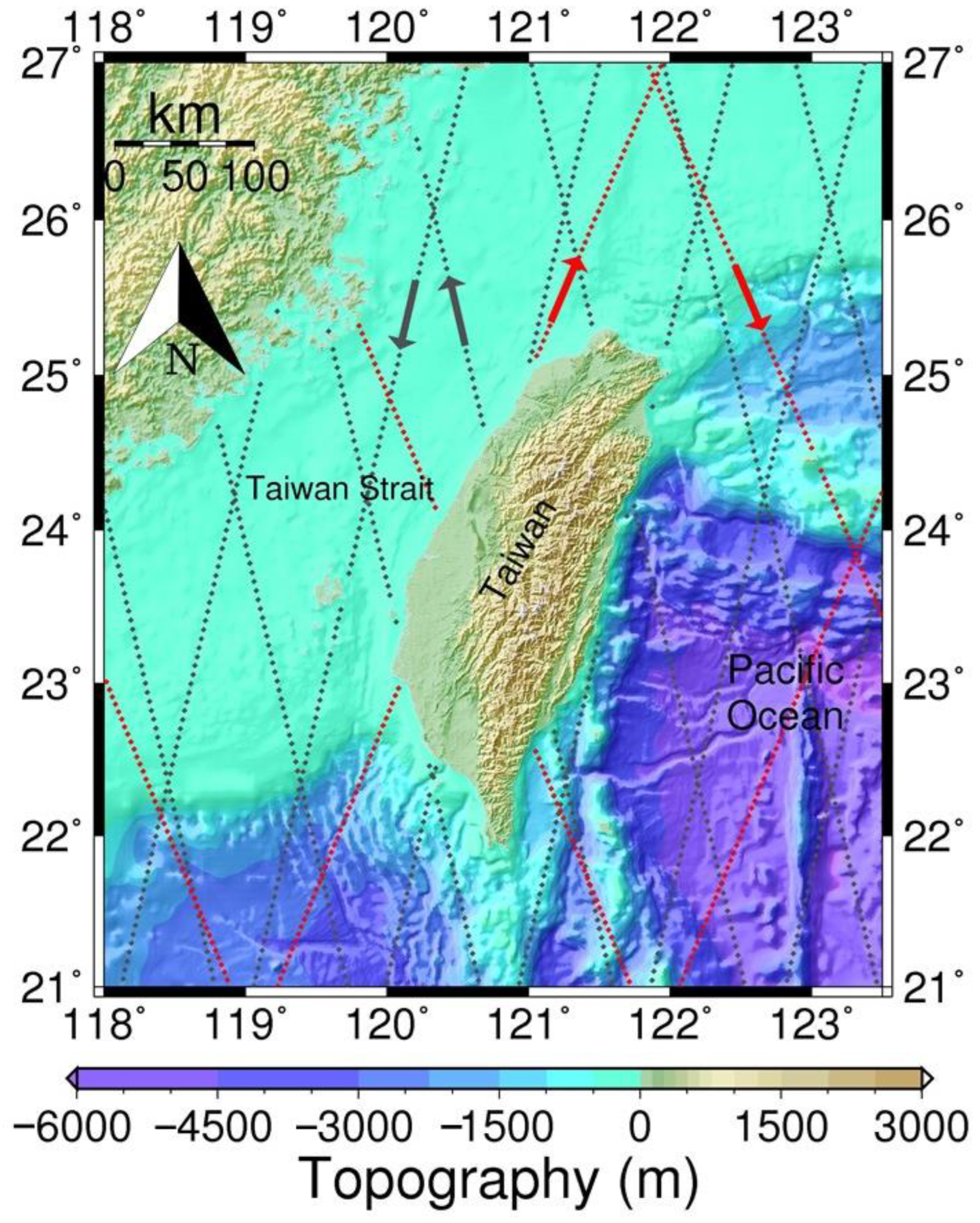
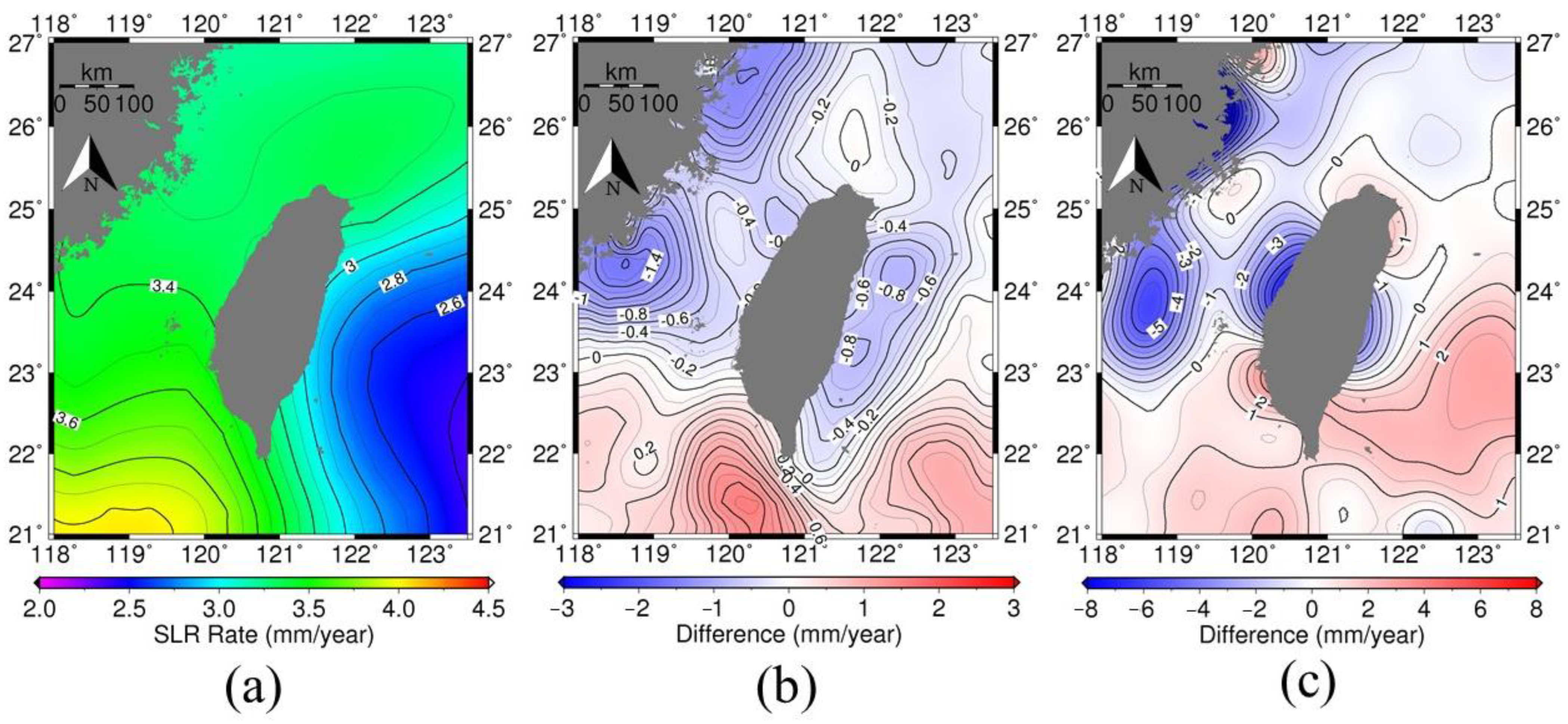
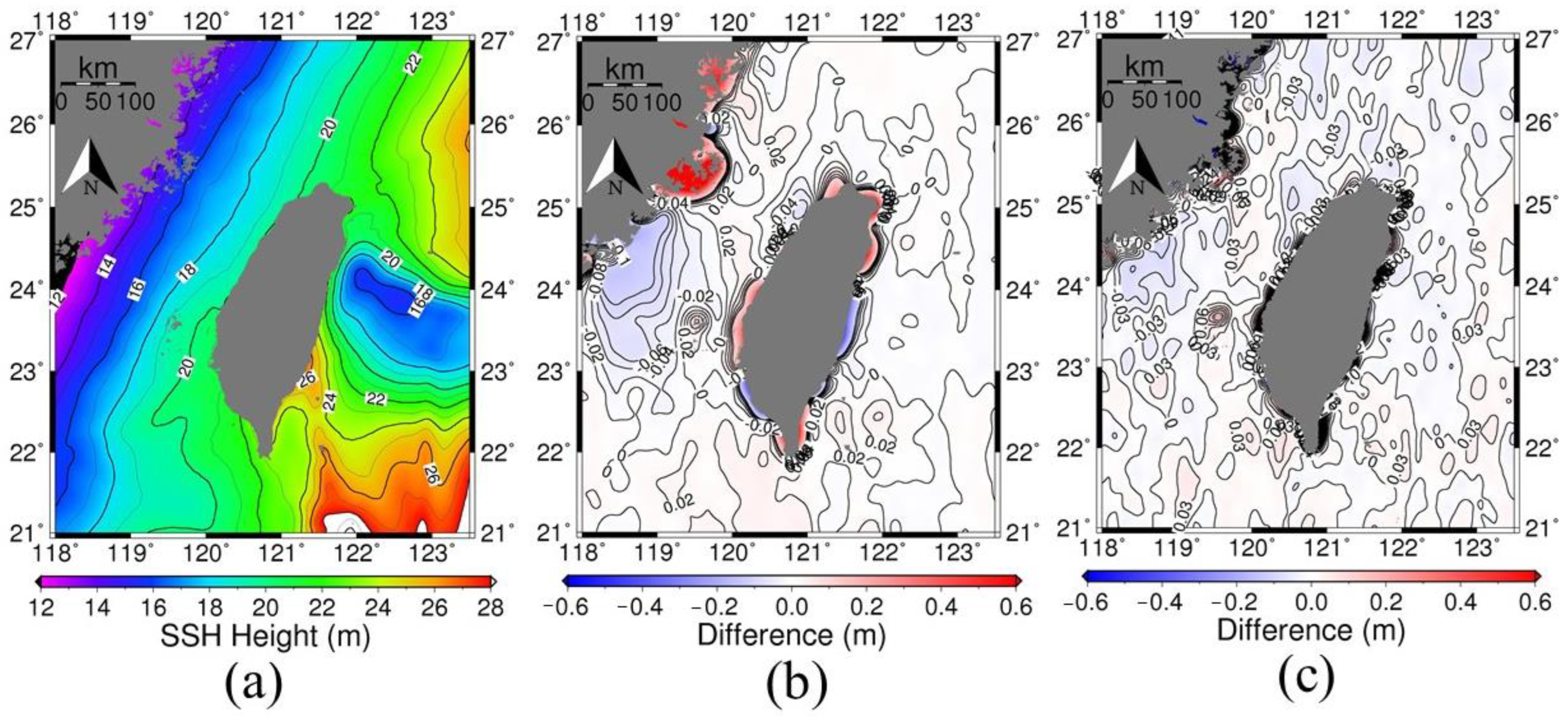
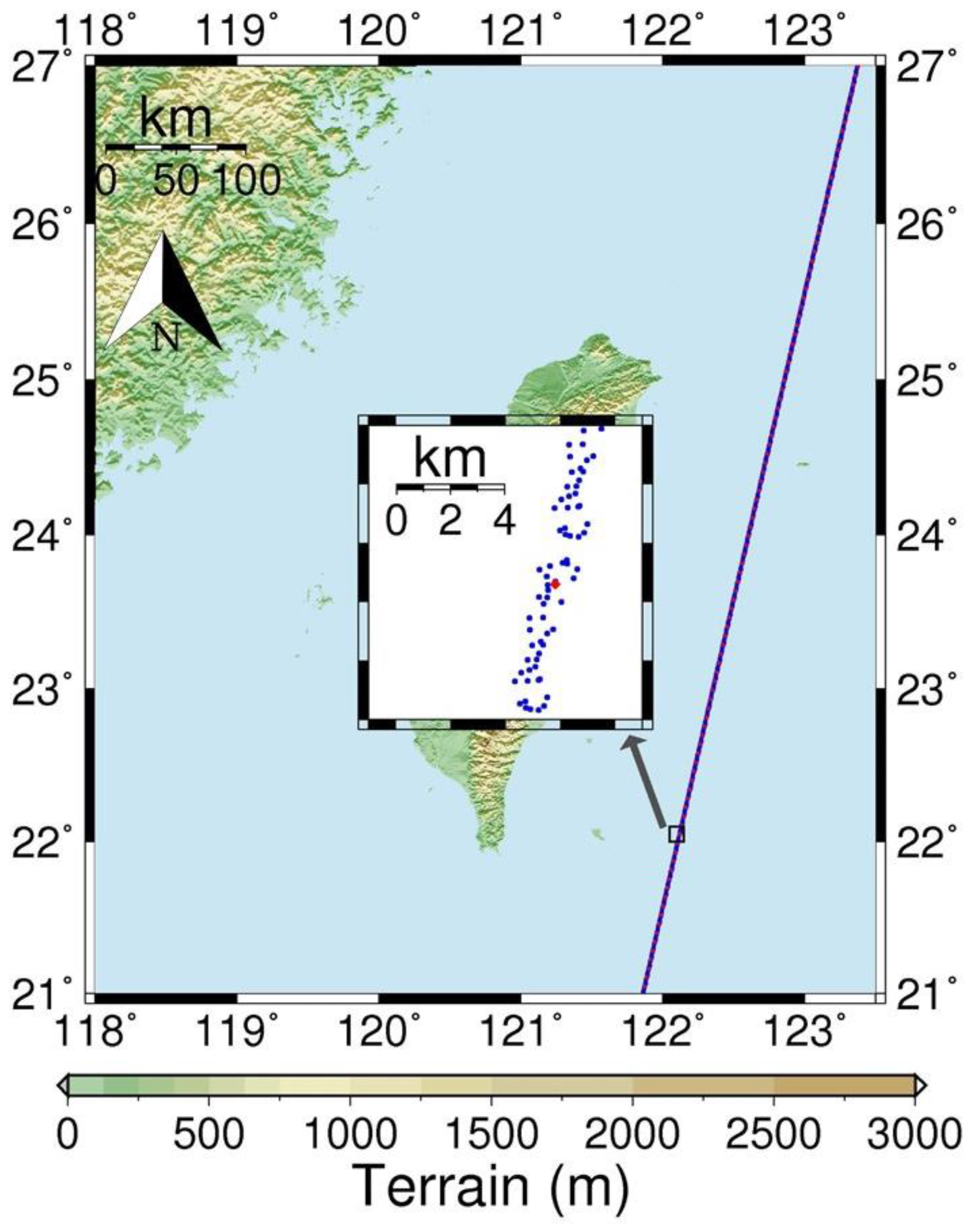
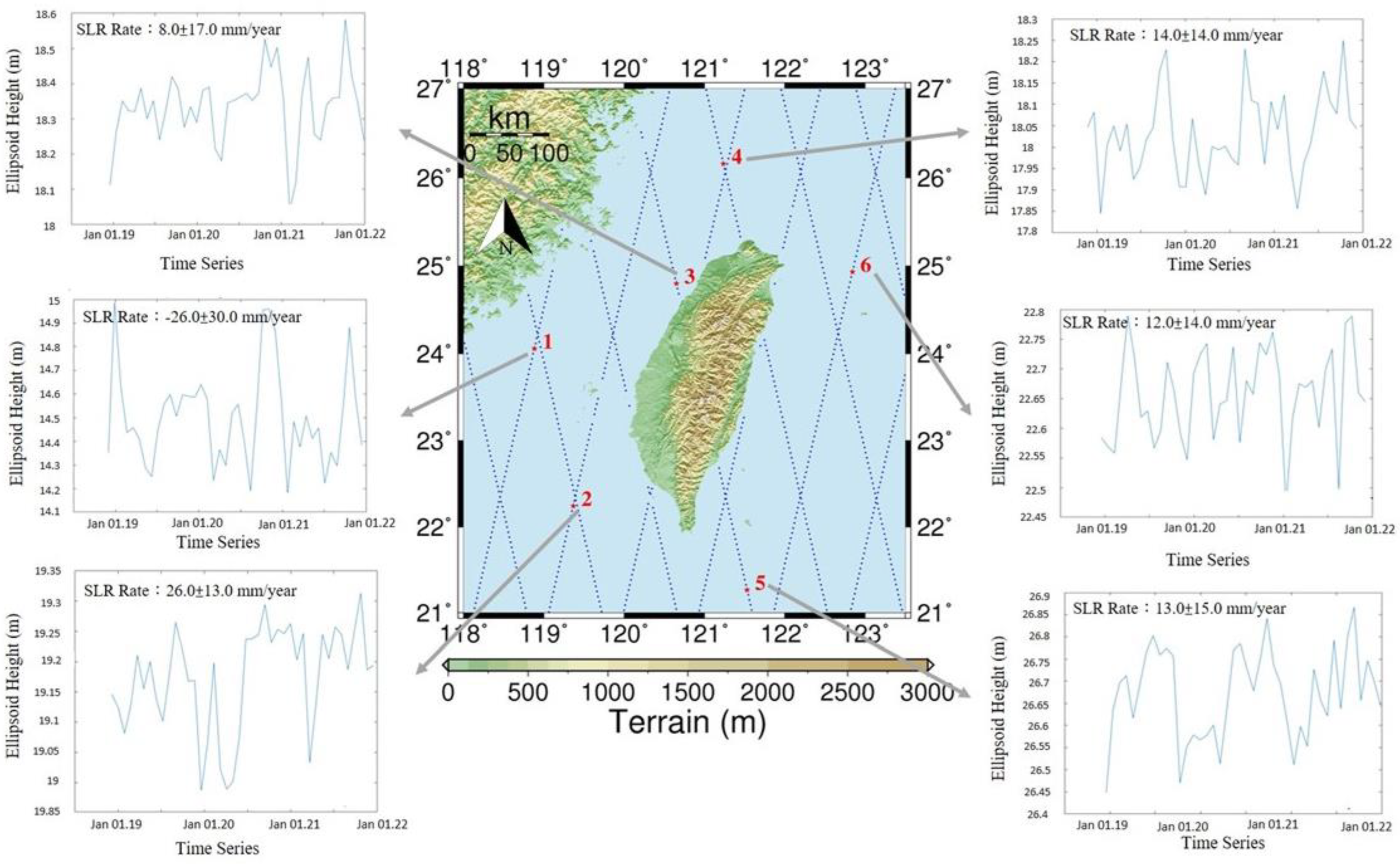
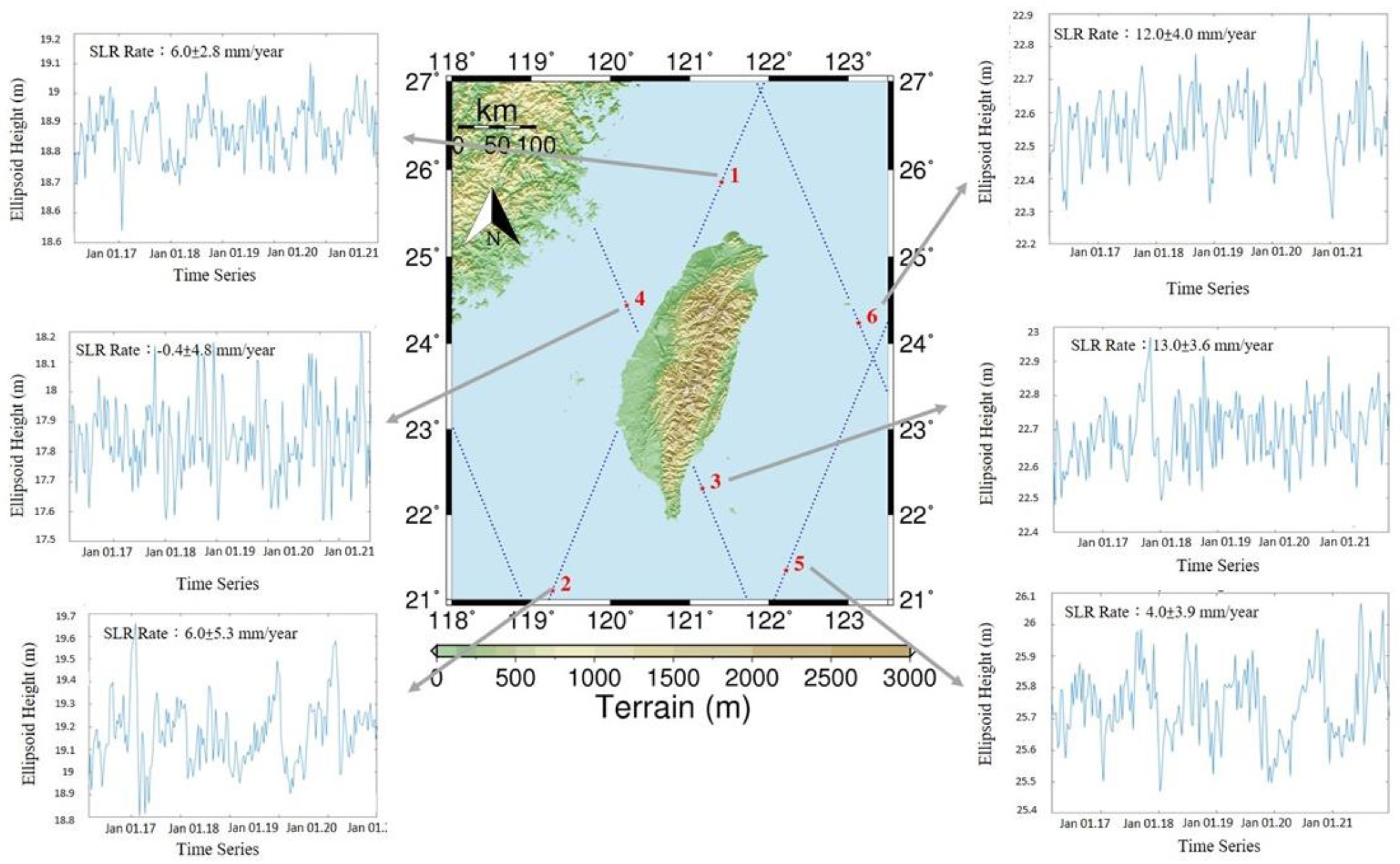


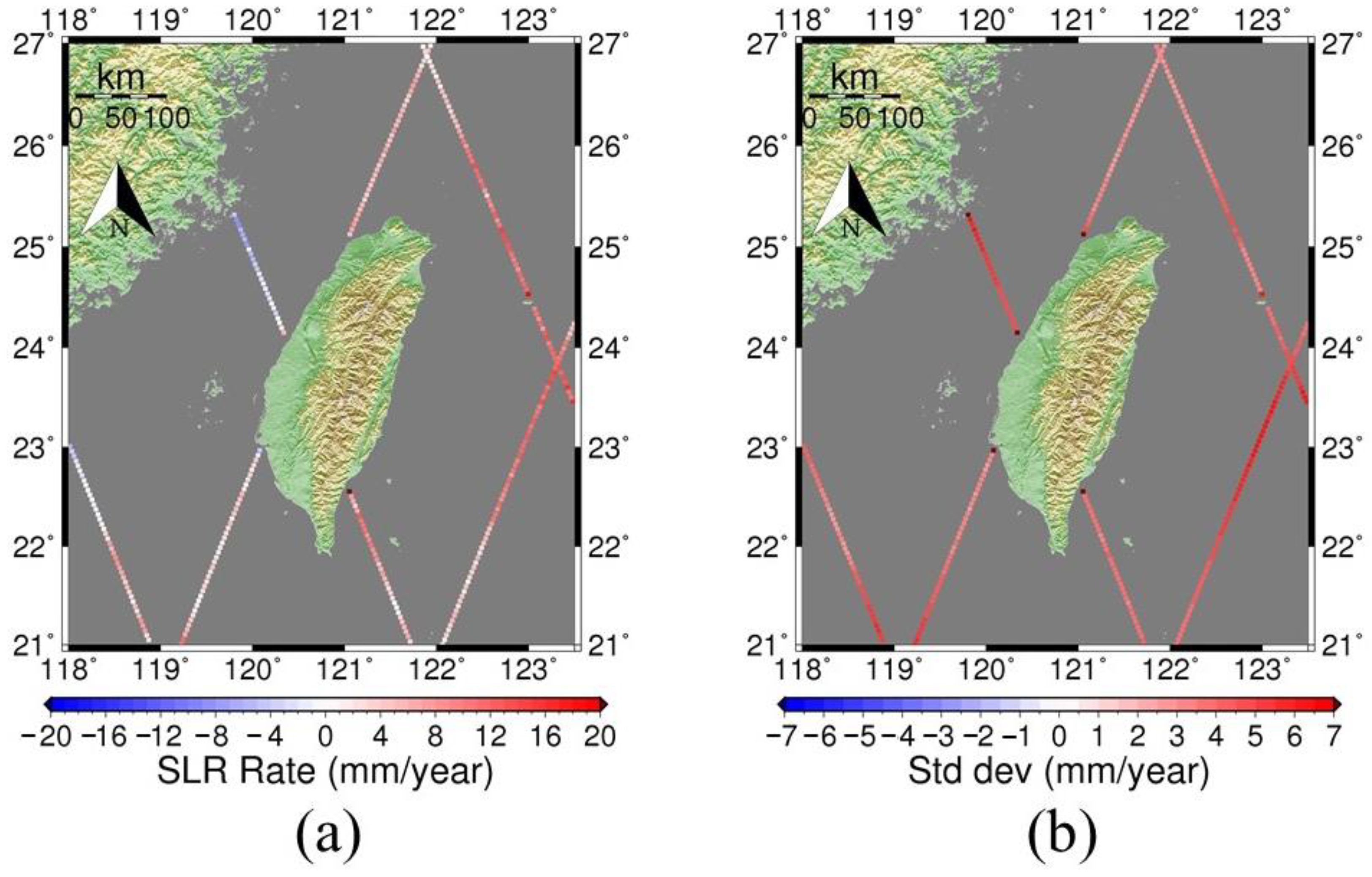
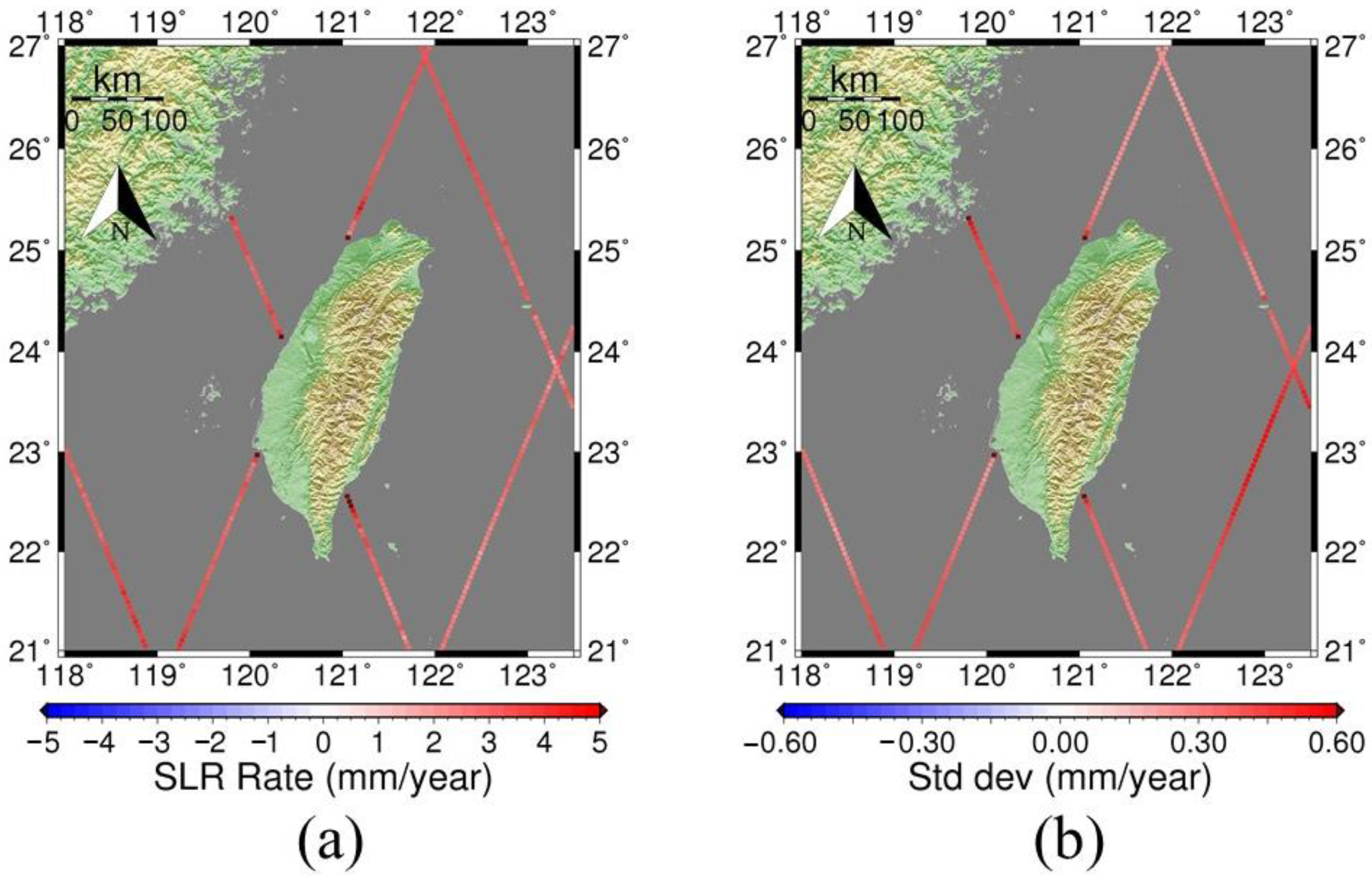


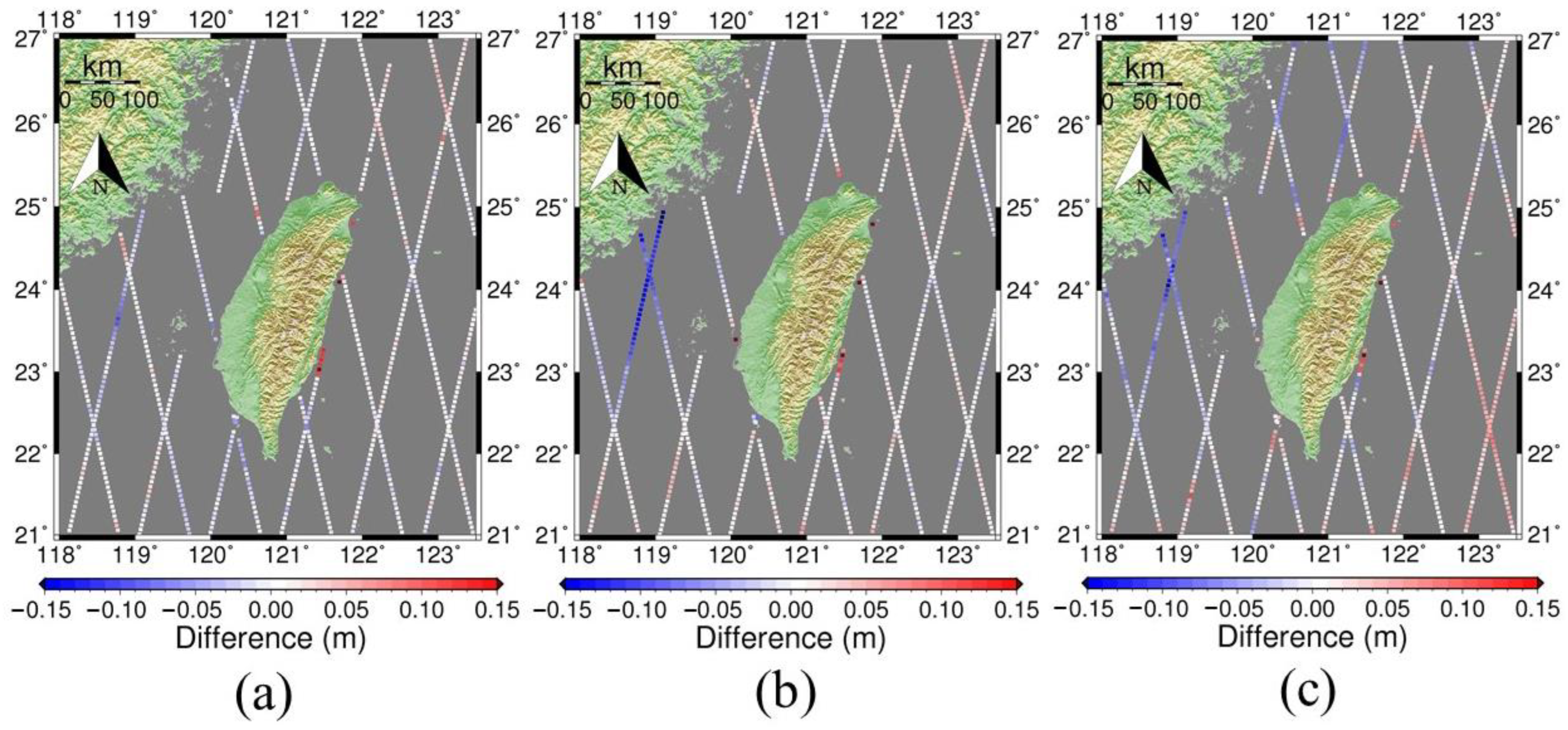
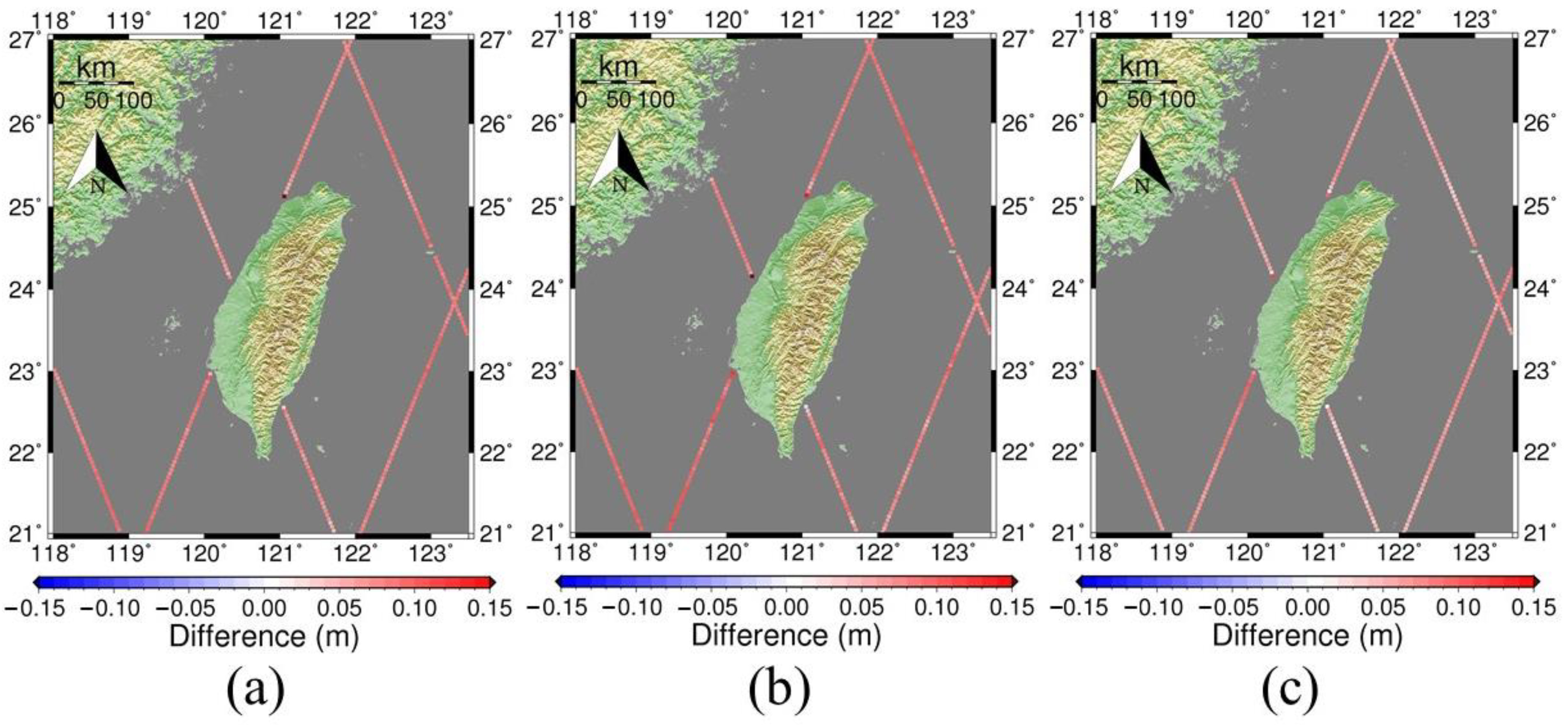
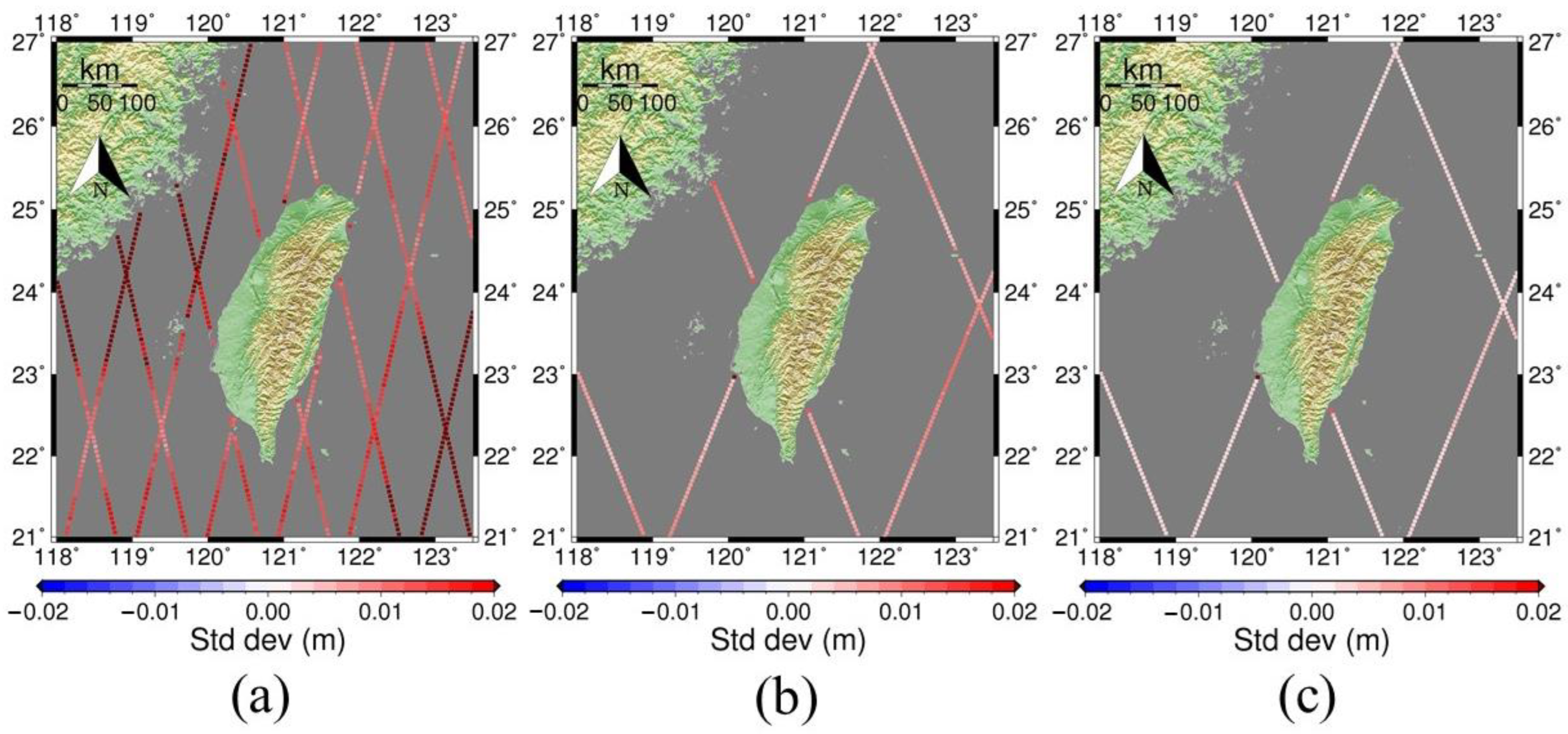
| Mission | Duration (Years) | Mean | Max. | Min. | Std. Dev. |
|---|---|---|---|---|---|
| S3B | 3 | 6.6 | 73.2 | −85.6 | 19.3 |
| J3 | 6 | 5.5 | 20.3 | −8.4 | 5.0 |
| T/P series | 29 | 3.3 | 5.7 | 1.8 | 0.5 |
| Mean | Max | Min | Std. Dev. | RMS | |
|---|---|---|---|---|---|
| S3B–NOAA | 3.4 | 69.2 | −88.8 | 19.4 | 19.6 |
| S3B–AVISO | 3.3 | 69.6 | −89.3 | 19.6 | 19.9 |
| J3–NOAA | 2.2 | 17.2 | −11.6 | 5.2 | 5.6 |
| J3–AVISO | 2.4 | 16.8 | −12.1 | 5.1 | 5.6 |
| Mean | Max. | Min. | Std. Dev. | RMS | |
|---|---|---|---|---|---|
| S3B-CLS15 | 0.0840 | 0.1816 | −0.0178 | 0.0206 | 0.0865 |
| S3B-DTU18 | 0.0813 | 0.1800 | −0.1017 | 0.0353 | 0.0886 |
| S3B-NCTUMSS | 0.0843 | 0.2059 | −0.0354 | 0.0313 | 0.0899 |
| J3-CLS15 | 0.0775 | 0.1827 | 0.0206 | 0.0132 | 0.0786 |
| J3-DTU18 | 0.0823 | 0.1580 | −0.0176 | 0.0150 | 0.0836 |
| J3-NCTUMSS | 0.0822 | 0.1387 | 0.0248 | 0.0140 | 0.0834 |
Disclaimer/Publisher’s Note: The statements, opinions and data contained in all publications are solely those of the individual author(s) and contributor(s) and not of MDPI and/or the editor(s). MDPI and/or the editor(s) disclaim responsibility for any injury to people or property resulting from any ideas, methods, instructions or products referred to in the content. |
© 2023 by the authors. Licensee MDPI, Basel, Switzerland. This article is an open access article distributed under the terms and conditions of the Creative Commons Attribution (CC BY) license (https://creativecommons.org/licenses/by/4.0/).
Share and Cite
Hsiao, Y.-S.; Hwang, C.; Chen, T.-W.; Cho, Y.-H. Assessing Models of Sea Level Rise and Mean Sea Surface with Sentinel-3B and Jason-3 Altimeter Data near Taiwan: Impacts of Data Quality and Length. Remote Sens. 2023, 15, 3640. https://doi.org/10.3390/rs15143640
Hsiao Y-S, Hwang C, Chen T-W, Cho Y-H. Assessing Models of Sea Level Rise and Mean Sea Surface with Sentinel-3B and Jason-3 Altimeter Data near Taiwan: Impacts of Data Quality and Length. Remote Sensing. 2023; 15(14):3640. https://doi.org/10.3390/rs15143640
Chicago/Turabian StyleHsiao, Yu-Shen, Cheinway Hwang, Te-Wei Chen, and Yu-Hsuan Cho. 2023. "Assessing Models of Sea Level Rise and Mean Sea Surface with Sentinel-3B and Jason-3 Altimeter Data near Taiwan: Impacts of Data Quality and Length" Remote Sensing 15, no. 14: 3640. https://doi.org/10.3390/rs15143640
APA StyleHsiao, Y.-S., Hwang, C., Chen, T.-W., & Cho, Y.-H. (2023). Assessing Models of Sea Level Rise and Mean Sea Surface with Sentinel-3B and Jason-3 Altimeter Data near Taiwan: Impacts of Data Quality and Length. Remote Sensing, 15(14), 3640. https://doi.org/10.3390/rs15143640








